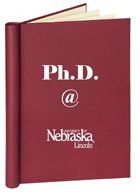Graduate Studies, UNL

Dissertations and Doctoral Documents, University of Nebraska-Lincoln, 2023–
First Advisor
Adam Larios
Degree Name
Doctor of Philosophy (Ph.D.)
Committee Members
Petronela Radu, George Avalos, Huijing Du, Florin Bobaru
Department
Mathematics
Date of this Version
5-2024
Document Type
Dissertation
Citation
A dissertation presented to the faculty of the Graduate College at the University of Nebraska in partial fulfilment of requirements for the degree of Doctor of Philosophy
Major: Mathematics
Under the supervision of Professor Adam Larios
Lincoln, Nebraska, May 2024
Abstract
Voigt regularization is a technique used to model turbulent flows, offering advantages such as sharing steady states with the Navier-Stokes equations and requiring no modification of boundary conditions. We explore a modification to the Voigt regularization technique by introducing fractional dissipation into the system, specifically incorporating a fractional power, r. In this work, the proofs are in the context of periodic boundary conditions. The resulting fractional Navier-Stokes-Voigt (fNSV) and fractional Euler-Voigt (fEV) equations are studied for global well-posedness in three dimensions. It is shown that global well-posedness holds in the 3D case for fEV when the fractional power r > 5/6, and for fNSV when r ≥ 1/2. Moreover, we show that the solutions of the fractional Voigt-regularized system converge to solutions of the original equations, on the corresponding time interval of existence of the latter, as the regularization parameter α → 0. Additionally, we prove convergence of solutions of fNSV to solutions of fEV as the viscosity ν → 0 as well as the convergence of solutions of fNSV to solutions of the Euler equations as both α, ν → 0. Furthermore, we derive a criterion for finite-time blow-up for each system based on this regularization.
We analyze computational results done at a spatial grid resolution of 2563 and consider the validity of the regularized equations. We observe the structure of coherent vortex tubes, that is, the level sets of the enstropy. We compare the vortex tubes of both unresolved and resolved simulations of the Navier-Stokes equations against simulations with the same parameters, except that the fractional Voigt and Voigt regularizations are applied. We examine how the fractional Voigt regularization effects the energy spectrum of under-resolved flows. We show the energy spectra of simulation runs at a Reynolds number of Re ≈ 4500. All runs are compared against a resolved DNS run at resolution 10243.
A somewhat separate approach to modeling physical phenomena is with nonlocal operators. We investigate the explicit convergence rates of nonlocal peridynamic operators to their classical (local) counterparts in Lq-norm. Previous results used Fourier series and hence were restricted to showing convergence in L2. Moreover, convergence rates were not explicit due to the use of the Lebesgue Dominated Convergence Theorem. Some previous results have also used the Taylor Remainder Theorem in differential form, but this often required an assumption of bounded fifth-order derivatives. We do not use these tools, but instead use the Hardy-Littlewood Maximal function, and combine it with the integral form of the Taylor Remainder Theorem. This approach allows us to establish convergence in the Lq-norm (1 ≤ q ≤ ∞) for nonlocal peridynamic partial derivatives, which immediately yields convergence rates for the corresponding nonlocal peridynamic divergence, gradient, and curl operators to their local counterparts as the radius (also known as "horizon") of the nonlocal interaction δ → 0. Moreover, we obtain an explicit rate of order O(δ2). This result contributes to the understanding of the relationship between nonlocal and local models, which is essential for applications in multiscale modeling and simulations.
Finally, we investigate a nonlocal variant of the linear scalar conservation equation in peridynamics. This model substitutes the traditional local divergence operator with an integral operator, characterized by a radial kernel with compact support in a ball of small radius, often referred to as the "horizon.'' Such operators have appeared in several recent studies. We successfully establish the global well-posedness of our model. However, contrary to expectations, we find that as the nonlocal horizon goes to zero, the convergence of solutions to those of the local model is not guaranteed and may not even hold, as suggested by our numerical simulations, except in scenarios involving constant velocity. Interestingly, introducing a local diffusion term results in the convergence of solutions to those of the local equation with diffusion. This finding serves as a cautionary note in the study of nonlocal peridynamics, indicating that even when one has convergence of the operators, convergence of solutions should not be taken for granted.
Advisor: Adam Larios
Recommended Citation
Safarik, Isabel, "Mathematical and Computational Analysis of Certain Regularizations for the 3D Navier-Stokes Equations and Nonlocal Peridynamic Conservation Laws" (2024). Dissertations and Doctoral Documents, University of Nebraska-Lincoln, 2023–. 99.
https://digitalcommons.unl.edu/dissunl/99


Comments
Copyright 2024, Isabel Safarik. Used by permission